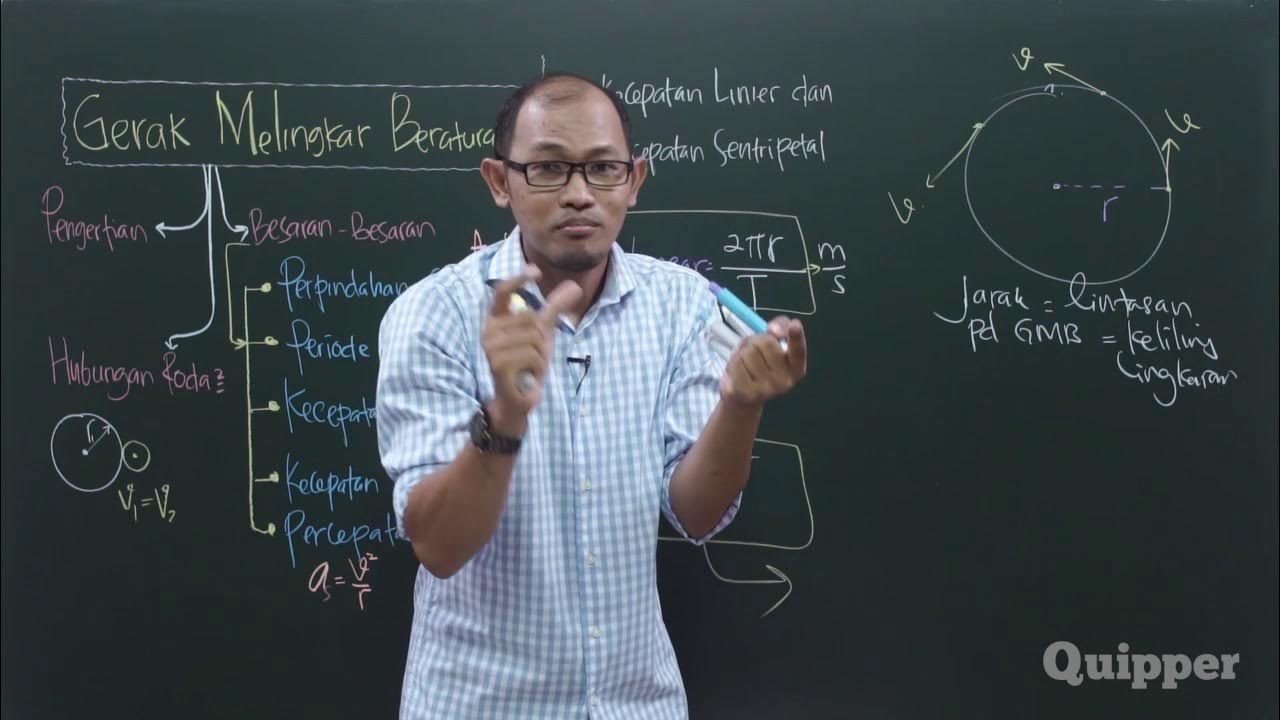F293-Gerak melingkar ,percepatan sudut,percepatan linier,percepatan sentripetal,percepatan mutlak
Summary
TLDRThis video explains various types of acceleration in circular motion. It covers angular acceleration, including both average and instantaneous forms, and explains how to calculate them using key formulas. The video also delves into linear (tangential) acceleration, showing its relationship with angular acceleration. Additionally, it discusses centripetal acceleration, emphasizing its direction towards the circle's center, and centrifugal acceleration, pointing away from the center. Finally, the concept of total or absolute acceleration is introduced, combining tangential and centripetal accelerations for a comprehensive understanding of motion in a circular path.
Takeaways
- 🔄 Angular acceleration is defined as the rate of change of angular velocity per unit of time.
- 📏 There are two types of angular acceleration: average angular acceleration and instantaneous angular acceleration.
- 🔢 Average angular acceleration is calculated using the formula: α = Δω / Δt, where Δω is the change in angular velocity and Δt is the time interval.
- 📉 Instantaneous angular acceleration is the derivative of angular velocity with respect to time, represented as dω/dt.
- 🧭 Angular acceleration is a vector quantity, meaning it has both magnitude and direction, determined using the right-hand rule.
- 📐 Tangential acceleration is related to angular acceleration and is defined as the rate of change of linear velocity per unit of time.
- 🔀 The relationship between tangential acceleration and angular acceleration is given by a_tangential = α * r, where r is the radius of the circular path.
- ⚙️ Centripetal acceleration always points towards the center of the circular path and is given by the formula a_c = ω² * r.
- ⚡ The total or absolute acceleration is the resultant of both tangential and centripetal accelerations, calculated using the Pythagorean theorem: a_total = √(a_c² + a_tangential²).
- 🧮 Example problems demonstrate how to calculate angular acceleration, tangential acceleration, and centripetal acceleration in various scenarios.
Q & A
What is angular acceleration in circular motion?
-Angular acceleration is the rate of change of angular velocity over time. It is measured in radians per second squared (rad/s²) in the SI unit system.
How is average angular acceleration calculated?
-Average angular acceleration is calculated using the formula α = Δω / Δt, where Δω is the change in angular velocity and Δt is the time interval.
What is instantaneous angular acceleration?
-Instantaneous angular acceleration is the limit of the average angular acceleration as the time interval approaches zero. It is the derivative of angular velocity with respect to time.
How can the direction of angular acceleration be determined?
-The direction of angular acceleration can be determined using the right-hand rule. If the fingers of your right hand curl in the direction of the rotation, the thumb points in the direction of the angular acceleration.
What is tangential or linear acceleration in circular motion?
-Tangential or linear acceleration is the rate of change of linear velocity over time. It can be related to angular acceleration by the formula a_t = α * r, where α is the angular acceleration and r is the radius of the circular path.
How is average tangential acceleration calculated?
-Average tangential acceleration is calculated as the change in linear velocity over the change in time, a_t = Δv / Δt, where Δv is the change in linear velocity.
What is the relationship between angular acceleration and tangential acceleration?
-Tangential acceleration is directly proportional to angular acceleration. The formula a_t = α * r shows that tangential acceleration increases with angular acceleration if the radius (r) remains constant.
What is centripetal acceleration, and how is it calculated?
-Centripetal acceleration is the acceleration directed towards the center of the circular path. It is calculated using the formula a_c = ω² * r, where ω is the angular velocity and r is the radius of the circular path.
What is total or absolute acceleration in circular motion?
-Total acceleration is the resultant of both tangential and centripetal accelerations. It is calculated using the Pythagorean theorem: a_total = √(a_t² + a_c²), where a_t is tangential acceleration and a_c is centripetal acceleration.
How do you find angular acceleration and tangential acceleration from a given equation of angular velocity?
-To find angular acceleration, take the derivative of the angular velocity equation with respect to time. For tangential acceleration, multiply the angular acceleration by the radius of the circular motion.
Outlines

This section is available to paid users only. Please upgrade to access this part.
Upgrade NowMindmap

This section is available to paid users only. Please upgrade to access this part.
Upgrade NowKeywords

This section is available to paid users only. Please upgrade to access this part.
Upgrade NowHighlights

This section is available to paid users only. Please upgrade to access this part.
Upgrade NowTranscripts

This section is available to paid users only. Please upgrade to access this part.
Upgrade NowBrowse More Related Video
5.0 / 5 (0 votes)





